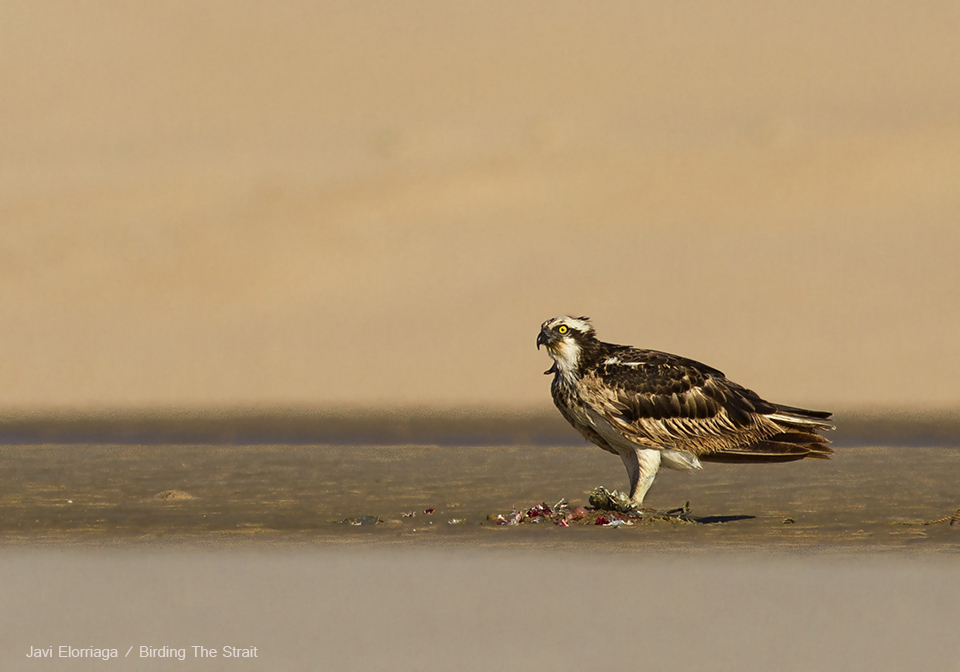
Day 8, 20 February: Bay of Dakhla by boat
The day broke clear and calm, so we decided that we would dedicate it to navigate the Bay of Dakhla on a boat provided by Dakhla Attitude hotel..
We did two trips, the first one in the morning which lasted three hours, and the second one, two hours long, in the afternoon. We weren’t sure what we would find or where to go, as there were no reports of birding boat trips in the bay, so we planned these trips according to what we’ve learned on previous days, going to the places where we had seen more birds and that were inaccessible from land. In addition, we programmed the survey of the NE end of the Bay where a few days later a male Orca was photographed close to the shore by some guests of Dakhla Attitude Hotel. Despite the poor existing information, it is know that Orcas, Bottlenose and Atlantic Humpback Dolphins do regularly occur within the Bay.
The morning was good in terms of seeing high numbers of birds and adding two species to our list: Pomarine Skua and Razorbill. It’s remarkable how some pelagic species can be seen here inside the bay, and not far from the coastline. Aside from the aforementioned species, we could see several European Storm-Petrels, Northern Gannets and Royal Terns.


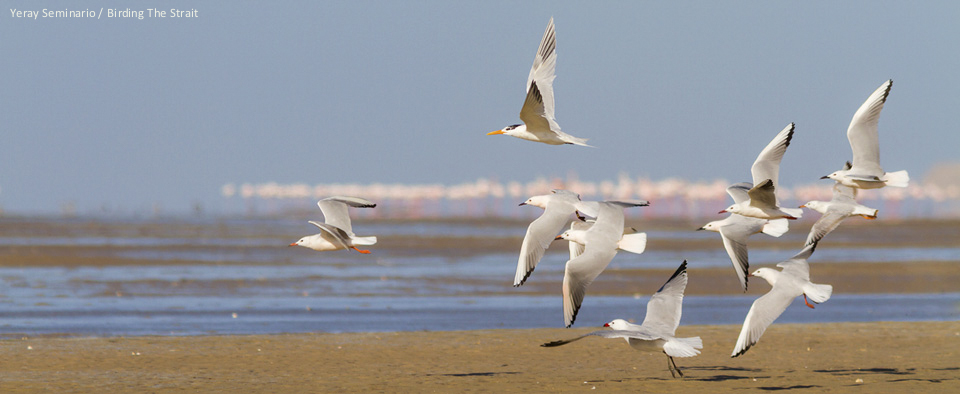

The afternoon was very successful regarding photography opportunities. We enjoyed a beautiful afternoon light spreading over hundreds of birds on the shore, against a desert, sand-dune background. Some birds would fly right in front of our boat, and others just walk or sit on the shore, at a short distance from us. There were more than 60 Slender-billed and 200 Audouin’s Gulls, as well as Caspian and Royal Terns, hundreds of waders, spoonbills and flamingos.
At the end of the day the boat docked in front of the hotel and we walked to our rooms enjoying a beautiful sunset.
Day 9, 21 February: East Bay of Dakhla, Duna Blanca & Gleb Jdiane
In our last day we visited some of the best birding spots in the region. The first one, Duna Blanca, we already visited before, but now we wanted to explore the full possibilities of the place and surroundings with low tide, which is the best time to see waders and other waterbirds. This turned out to be a good decision, as we witnessed one of the largest concentrations of birds of the trip.
We started driving on the sand towards the white dune and jumped out of the car to climb to the top and set our scopes. From there we got to see good numbers of waders, a few thousands, but they were distant, so we decided to move around the lagoon to a more advantageous point, closer to the birds. We had quite some work to do scanning thousands of birds, including: more than 150 Greater Flamingos, 150 Great Cormorants, 110 Eurasian Spoonbills, 1500 Bar-tailed Godwits, 1000 Dunlins, 200 Grey Plovers and 200 Eurasian Curlews, amongst others. In full excitement, Javi announced to have found one of the two Western Reef-Herons that had been reported recently in the area. That was a good bird to find, and added a good portion of enjoyment to an already amazing and beautiful place with hundreds of birds around.
We continued to explore the shoreline as the tide was rising. Not far from the observation point, where most of the waders were, we found an Osprey resting peacefully on a rusty sign in the water, and a little bit further, a flock of terns, which included 18 Royal Terns. Interested as we were to take good pictures of these birds for further documentation on future sightings in the Strait of Gibraltar, we approached the flock carefully and got some pics with the Caspian, Sandwich and Royal Terns against the beautiful Duna Blanca.
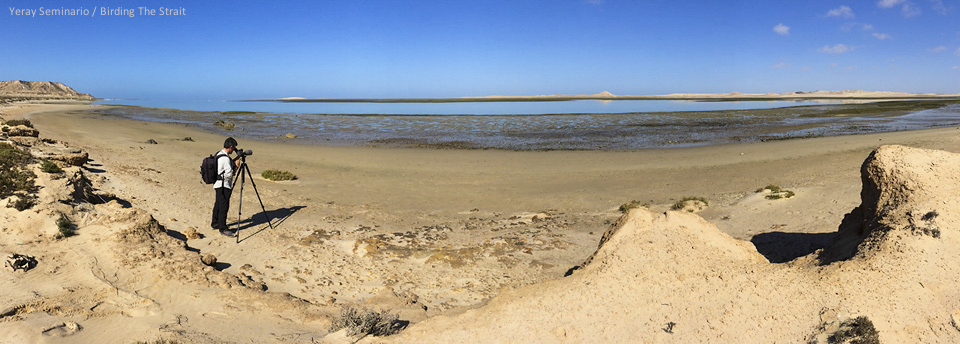
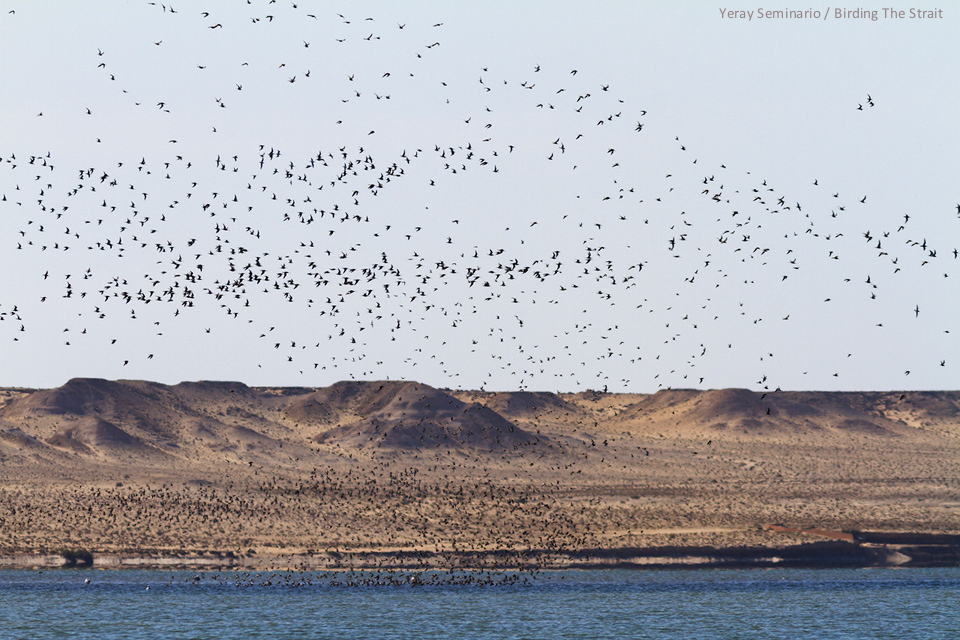
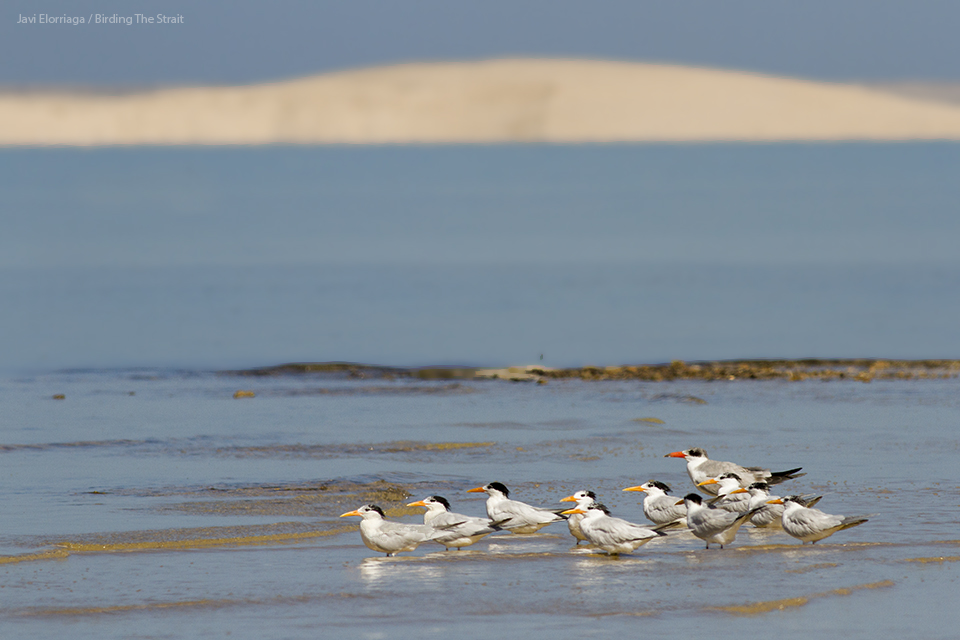
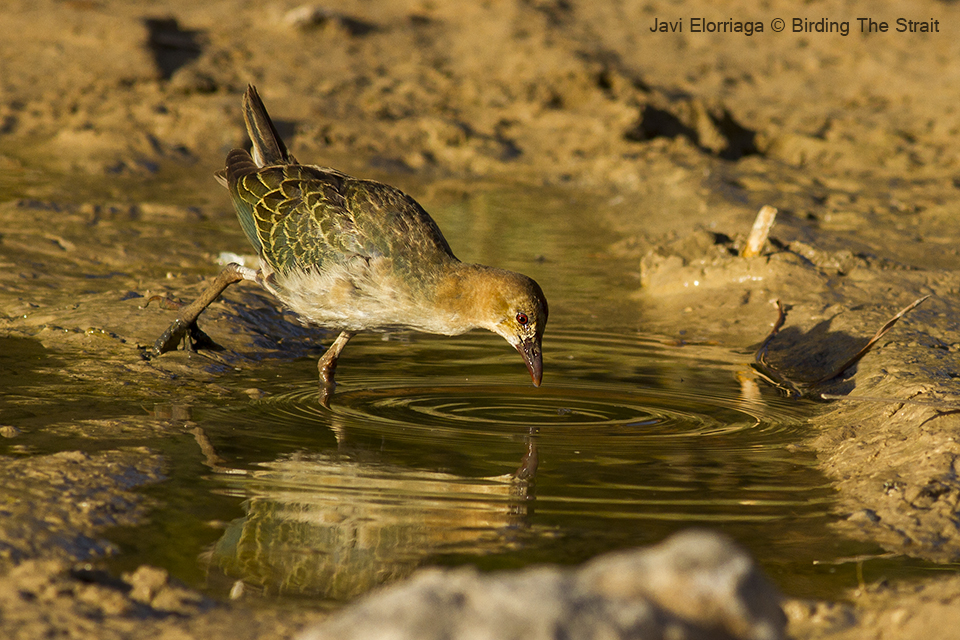
In the afternoon we headed out to Gleb Jdiane, a small well located on on the Dakhla-Aousserd road where an Allen’s Gallinule had been reported only a few days before by Mohamed Mediani. Coincidentally, Mohamed was at the place looking for the bird and we had a pleasant time chatting with him. With our hopes put on the Gallinule, we started to inspect the area. There were some passerines around, including several Chiffchaffs, Spectacled Warbler, Sedge Warbler and Trumpeter Finch, while the Stone Curlews called nearby. It didn’t pass long when a juvenile Allen’s Gallinule came out of the small patch of reeds into the small remaining puddle of water, very close to us! We could fully enjoy the bird for a long time, and then we decided it was time to explore a wadi, 5 Km to the east of Gleb Jdiane, and look for more desert specialties.
We inspected the desert plains and found some good birds, including Temminck’s Lark, which had eluded us until then, along with Greater Hoopoe-Lark, Bar-tailed Lark and Thekla Lark from the subspecies ruficolor.
After a beautiful and satisfactory day we went back to Dakhla Attitude to pack for our early flight back to Spain next morning and celebrate a much rewarding scouting trip with an excellent dinner.
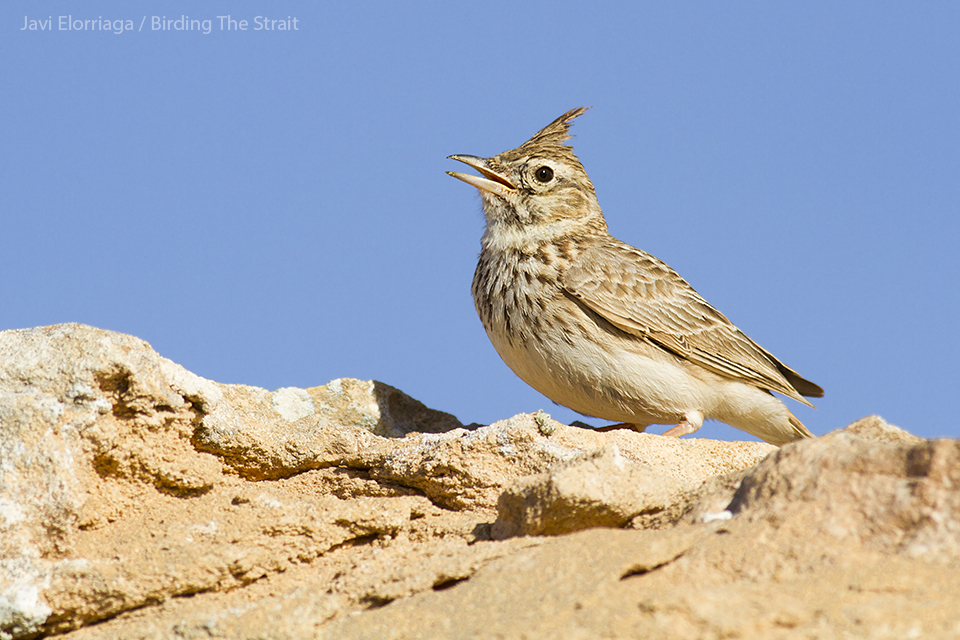

Summary
The Dakhla-Aousserd region is certainly an ultimate destination within the Western Paleartic region. The combination of marine ecosystems and marshes of the Bay with the Sahelian savanna and the rocky outcrops at the edge of the Sahara desert results in a region of unparalleled diversity and beauty. It does not only hold some extremely attractive species that can be difficult to find anywhere else in the Paleartic region, but it is place of great beauty. The landscape plays a predominant role here – seeing these birds in this setting, adds an incredible value to the experience.
We believe that this region is worth exploring for nature enthusiast interested, not only in birds, but plants, reptiles, mammals, landscape, ethnography and photography.
A visit to Aousserd is indispensable, either during a day-trip or, even better, spending one night camping in the desert. The road Dakhla-Aousserd is currently in excellent condition and there are numerous trails that can be used for exploring.
This is a quiet area with friendly locals and vast extensions of land to explore, with no signs of people, other than a few nomadic shepherds. We weren’t stopped at any of the police checkpoints, which might have had something to do with the fact that we were using Dakhla Attitude vehicles, but it’s important to note that we were carrying scopes, tripods and several tele-lenses with cameras, as usual, and that this was never a problem with the authorities nor were we asked about the purpose of such equipment.
Dakhla Attitude Hotel offers a perfect accommodation and all inclusive services for independent birders and groups visiting the area. The Hotel has a solid and well deserved reputation among european customers and tour-operators. It is strategically placed in the northern shore of the bay and the resort should be considered a birding hotspot itself. Moreover, it greatly facilitates the visits to both the West and East shores of the Bay and Gleb Jdiane (55km aprox). Remarkably, the hotel has its own boats, which are very useful for birding visits in the bay.

Acknowledgments
We want to thank the following people for helping us on the planning and the development of the trip:
First and Foremost, Bruno Muchada and Eva Pineda from Dakhla Attitude, who made this trip possible and devoted themselves to make our experience easy, comfortable and fully enjoyable. Many thanks! We would like to extend our gratitude to all the staff from Dakhla Attitude for their warmth and professionalism.
The people from Association Nature Initiative, specially Taoufik El Balla and Mohamed Samlali, who shared their knowledge with us and with whom we had the chance to enjoy a fabulous journey in the desert.
Friends who provided valuable information and inspiration during the planning of this trip: Patrick Bergier, Pedro del Campo, Mohamed Mediani, Juan José Ramos, Bob Swan and Ignacio Yúfera.
We eagerly recommend visiting the specialized Go-south website for updated information about the most relevant ornithological information of the region.
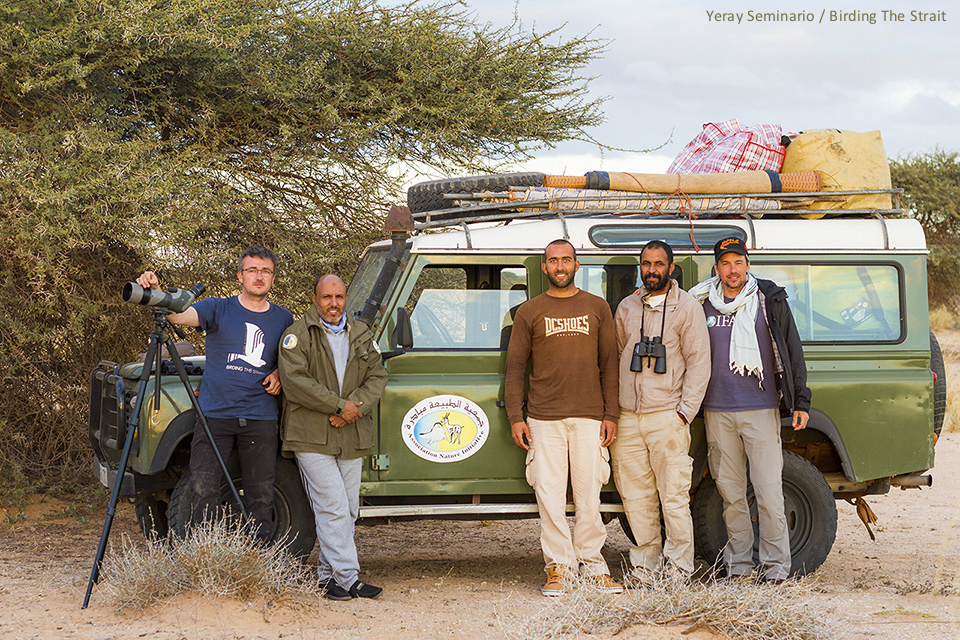
Bird List Dakhla-Aousserd Region
All our records, including locations, numbers of birds and other details, can be found on eBird. A larger set of pictures on higher definition can be found here.
13 – 21 February 2016
1. Northern Pintail – Anas acuta
2. Greater Flamingo – Phoenicopterus roseus
3. European Storm-Petrel – Hydrobates pelagicus
4. White Stork – Ciconia ciconia
5. Northern Gannet – Morus bassanus
6. Great Cormorant – Phalacrocorax carbo
7. Gray Heron – Ardea cinerea
8. Little Egret – Egretta garzetta
9. Western Reef-Heron – Egretta gularis
10. Eurasian Spoonbill – Platalea leucorodia
11. Osprey – Pandion haliaetus
12. Short-toed Snake-Eagle – Circaetus gallicus
13. Black Kite – Milvus migrans
14. Long-legged Buzzard – Buteo rufinus
15. Allen’s Gallinule – Porphyrio alleni
16. Eurasian Thick-knee – Burhinus oedicnemus
17. Pied Avocet – Recurvirostra avosetta
18. Eurasian Oystercatcher – Haematopus ostralegus
19. Black-bellied Plover – Pluvialis squatarola
20. Kentish Plover – Charadrius alexandrinus
21. Common Ringed Plover – Charadrius hiaticula
22. Common Sandpiper – Actitis hypoleucos
23. Common Greenshank – Tringa nebularia
24. Common Redshank – Tringa totanus
25. Whimbrel – Numenius phaeopus
26. Eurasian Curlew – Numenius arquata
27. Bar-tailed Godwit – Limosa lapponica
28. Ruddy Turnstone – Arenaria interpres
29. Red Knot – Calidris canutus
30. Sanderling – Calidris alba
31. Dunlin – Calidris alpina
32. Cream-colored Courser – Cursorius cursor
33. Great Skua – Stercorarius skua
34. Pomarine Jaeger – Stercorarius pomarinus
35. Parasitic Jaeger – Stercorarius parasiticus
36. Razorbill – Alca torda
37. Slender-billed Gull – Chroicocephalus genei
38. Mediterranean Gull – Ichthyaetus melanocephalus
39. Audouin’s Gull – Ichthyaetus audouinii
40. Yellow-legged Gull – Larus michahellis
41. Lesser Black-backed Gull – Larus fuscus
42. Little Tern – Sternula albifrons
43. Caspian Tern – Hydroprogne caspia
44. Royal Tern – Thalasseus maximus
45. Sandwich Tern – Thalasseus sandvicensis
46. Rock Pigeon – Columba livia
47. Eurasian Collared-Dove – Streptopelia decaocto
48. Laughing Dove – Streptopelia senegalensis
49. Great Spotted Cuckoo – Clamator glandarius
50. Pharaoh Eagle-Owl – Bubo ascalaphus
51. Little Owl – Athene noctua
52. Egyptian Nightjar – Caprimulgus aegyptius
53. Little Swift – Apus affinis
54. Eurasian Hoopoe – Upupa epops
55. Eurasian Kestrel – Falco tinnunculus
56. Lanner Falcon – Falco biarmicus
57. Southern Gray Shrike – Lanius meridionalis
58. Woodchat Shrike – Lanius senator
59. Brown-necked Raven – Corvus ruficollis
60. Greater Hoopoe-Lark – Alaemon alaudipes
61. Black-crowned Sparrow-Lark – Eremopterix nigriceps
62. Bar-tailed Lark – Ammomanes cinctura
63. Desert Lark – Ammomanes deserti
64. Thick-billed Lark – Ramphocoris clotbey
65. Dunn’s Lark – Eremalauda dunni
66. Thekla Lark – Galerida theklae
67. Temminck’s Lark – Eremophila bilopha
68. Bank Swallow – Riparia riparia
69. Rock Martin – Ptyonoprogne fuligula
70. Barn Swallow – Hirundo rustica
71. Red-rumped Swallow – Cecropis daurica
72. Common House-Martin – Delichon urbicum
73. Common Chiffchaff – Phylloscopus collybita
74. Iberian Chiffchaff – Phylloscopus ibericus
75. Sedge Warbler – Acrocephalus schoenobaenus
76. Cricket Longtail – Spiloptila clamans
77. Eurasian Blackcap – Sylvia atricapilla
78. African Desert Warbler – Sylvia deserti
79. Subalpine Warbler – Sylvia cantillans
80. Sardinian Warbler – Sylvia melanocephala
81. Spectacled Warbler – Sylvia conspicillata
82. Fulvous Chatterer – Turdoides fulva
83. Blue Rock-Thrush – Monticola solitarius
84. White-crowned Wheatear – Oenanthe leucopyga
85. Black Wheatear – Oenanthe leucura
86. Northern Wheatear – Oenanthe oenanthe
87. Red-rumped Wheatear – Oenanthe moesta
88. Desert Wheatear – Oenanthe deserti
89. Western Yellow Wagtail – Motacilla flava
90. White Wagtail – Motacilla alba
91. Trumpeter Finch – Bucanetes githagineus
92. House Sparrow – Passer domesticus
93. Desert Sparrow – Passer simplex